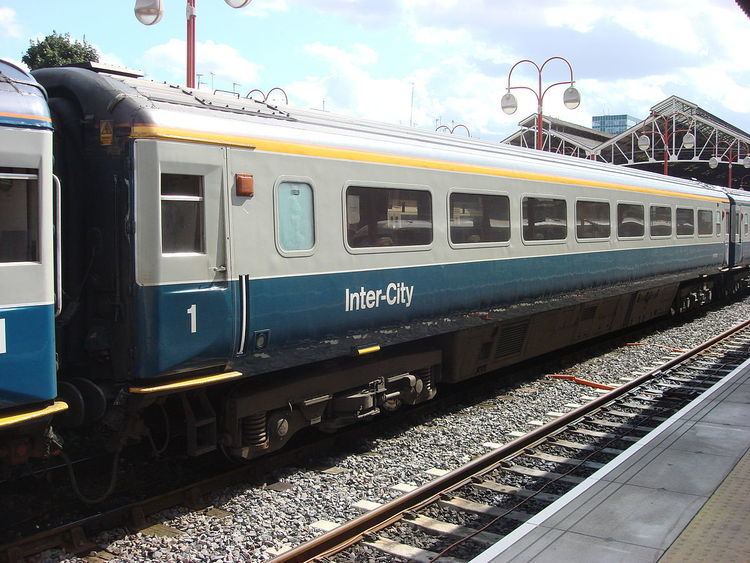In service 1951– | ||
 | ||
Constructed Mk1 1951–1963Mk2 1970-74Mk3 1976-85Mk4 1989-92 Fleet numbers Mk1 3000-3151Mk2c 3152-3169Mk2d 3170-3216Mk2e 3221-3275Mk2f 3276-3439Mk3 11000-11003/41003-41169Mk3a 11004-11063Mk3a 11064-11101Mk4 11200-11263 Capacity Mk1 42Mk2c/d/e/fMk3/a/b 48Mk4 46 | ||
A First Open or FO, is a type of railway carriage used by British Rail and subsequent operators since privatisation. They were first produced as British Railways Mark 1, and subsequently Mark 2, Mark 3, and Mark 4 variants were produced. This type of carriage is an "Open coach" because of the arrangement of the seats inside - other types of carriage may be corridor based variants (FK) or have a brake compartment (BFO or BFK).
Contents
Mark 1
First Open where introduced from 1951 with the first 3 for the midland region being the only Mk1 FO having no centre door seating 42 in 2+1 a format. Second batch 3003-19 built from 1954 had a centre door in with the centre seating bay. This split the middle window into two thin panes with the door in between. From 3020 have a separate centre vestibule with the and having a reduced width bays along with a centre vestibule and doors while still seating 42 in 2+1 format. BR1 type bogies were fitted as standard except 3076-3080 were a test bach built with Commonwealth bogies to improve ride quality. In 1961 changes were made to improve ride quality by replacing the BR1 bogie which quality which became bad after some use, 3101 - 3151 being built with commonwealth type bogie which became standard for a time, with the weight increasing by 5 tons. BR1 and commonwealth bogies usually run at a maximum of 90 mph (140 km/h). Later B4 bogies were fitted to further improve ride quality with a maximum of 100 mph (160 km/h). Fitted with Pullman gangways on standard 64 ft frames and fitted with buck-eye couplers as standard. Buck-eye couplers can be dropped and buffers extended to allow use of screw coupling fitted locomotives. Vacuum brakes and steam heating were fitted as standard with a number of Mk1 FO where later fitted with air brakes in the late 60's to 70's with some still retaining vacuum brakes and a number being dual braked (air and vacuum).
Livery
The livery initially for Mk1 coaches for British Railways in 1951 was crimson lake and cream with black and gold lining, all new Mk1 FO coaches were delivered in this livery up until 1956. In 1956 the standard livery changed to maroon with black and gold lining except for the Southern region stock which adopted an unlined dark malachite green. Western Region on the other hand adopted chocolate and cream to sufficient stock to operate its named trains like "Cornish Rivia Ltd" and "Torbay Express" being two examples. Southern region introduced the yellow UIC cantrail stripe denoting first class in 1960 for boat train coaches. Yellow UIC cantrail stripe was later introduced on other regions from 1963. In 1965 Manastral Blue & Grey livery was introduced as trailed on XP64 stock the year before and lasted for another 20 years.
Mark 1 FO conversions
In 1976, 13 First Open where converted to Restaurant Second Open No Kitchen 1058-1070 RSO, 12 were later converted to Second Open 3600-3610 SO in 1981-82, 5 of the remining SO in 1987 where converted back to First Open 31xx FO.
Mark 2
The first Mk2 First Open were built to Mk2c design in 1970 flowed by Mk2d from 1971 complete with air conditioning, with the ETH supply becoming standard along with a motor-alternator to provide the lighting, heating and air conditioning. The Mk2e was introduced in 1972-73 with introduction of fluorescent tubes for lighting with the major change being the more compact toilet. The final development was the Mk2f being introduced in 1973-75 which the interior design from the prototype Mk3s with improved seating and air conditioning through body side heaters. All the Mk2 veterans are fitted with B4 bogies with a maximum of 100 mph (160 km/h).
Mark 2 FO conversions
Mark 3
First Mk3 prototypes were built at Derby Litchurch Lane in 1972 for the new high speed train Class 252 and were built to 75 ft 0 in (22.86 m) with BT5 bogies with a maximum of 125 mph (201 km/h). Production built Mk3 stock for class 253 and 254 InterCity 125 were built by BR at Derby Litchurch Lane in 1975-82 with BT10 bogies with a maximum of 125 mph (201 km/h) seat 48 and referred to as a trailer First. Mk3a is the production built loco-hauled Mk3 built by BR at Derby Litchurch Lane introduced on the West Coast Main line in from 1975.
From 1979, seven First Open were used on the Glaggow to Edinburgh push pull service 11004-11010 with 11022 added later as 11004 was involved in the Polmont rail accident in 1984. ScotRail later down graded its First Open in 1986 to Open Composite were renumbered 119xx. Two First Open 11021 and 11032 were fitted with BT15 bogies along with 11058 fitted with BTS bogies in the mid-1980s.
With a further order for 38 Mk3b built by BR at Derby Litchurch Lane in 1985 and were delivered new in InterCity livery with a number receiving names and being used on services on the West Coast main line offering a first class Pullman service.
Mark 3 FO conversions
Mark 4
Built in 1988 by Metro Cammell at their Washwood Heath plant in Birmingham, the coaches are 23 m (75 ft 5 1⁄2 in) long with power-operated sliding plug doors, are fitted with SIG bogies and are capable of running at up to 140 mph (225 km/h), but usually run at a maximum of 125 mph (201 km/h).
